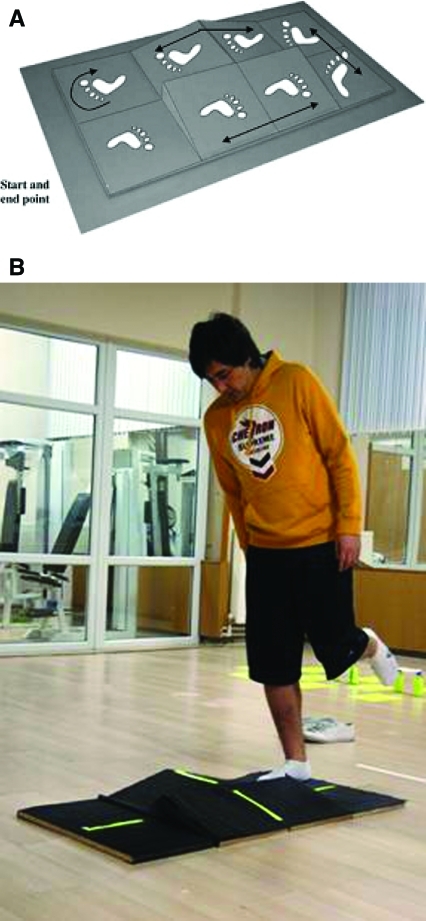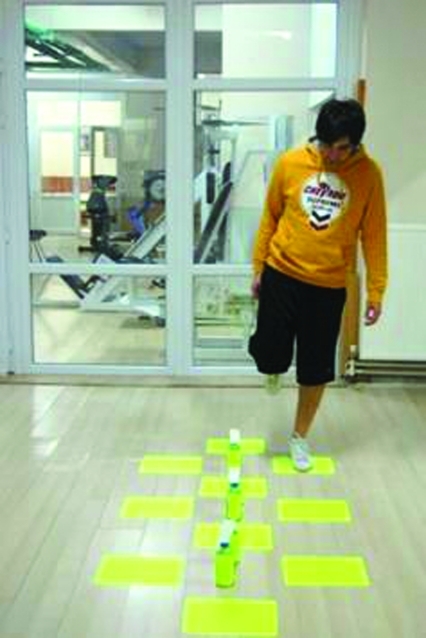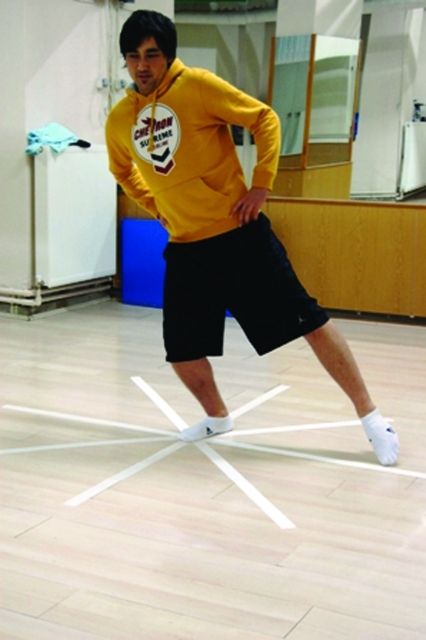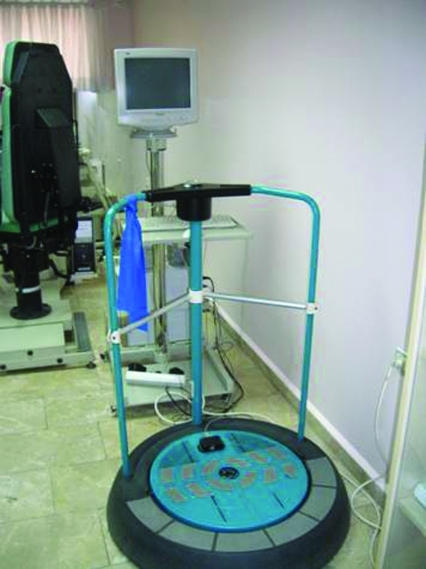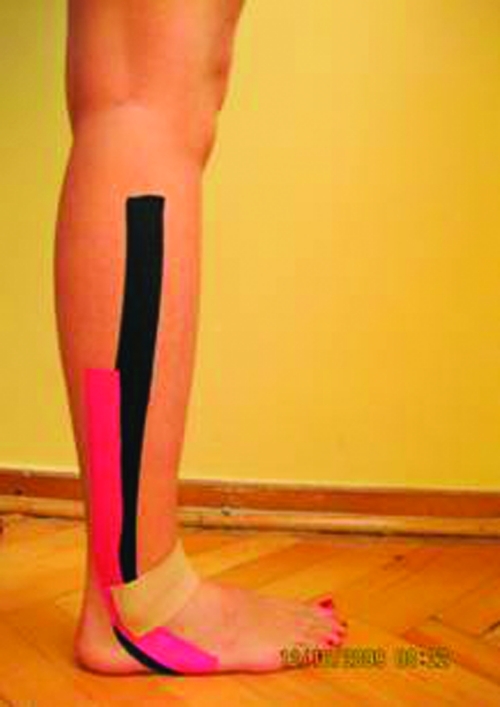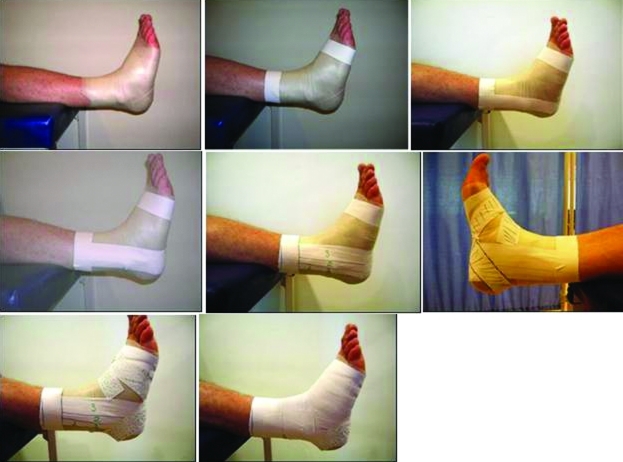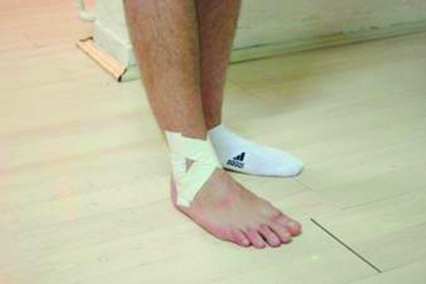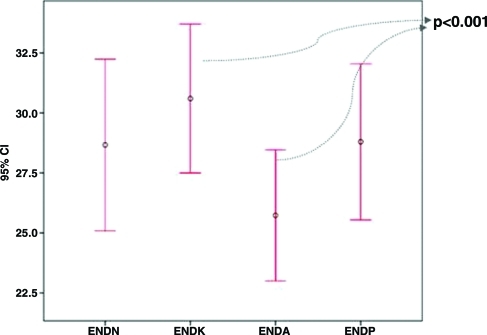Abstract
Background:
Chronic inversion ankle sprains are common in basketball players. The effect of taping on functional performance is disputed in the literature. Kinesiotaping® (KT®) is a new method that is being used as both a therapeutic and performance enhancement tool. To date, it appears that no study has investigated the effect of ankle KT® on functional performance.
Purpose:
To investigate the effects of different types of taping (KT® using Kinesio Tex®, athletic taping) on functional performance in athletes with chronic inversion sprains of the ankle.
Study Design:
Crossover Study Design
Methods:
Fifteen male basketball players with chronic inversion ankle sprains between the ages of 18 and 22 participated in this study. Functional performance tests (Hopping test by Amanda et al, Single Limb Hurdle Test, Standing Heel Rise test, Vertical Jump Test, The Star Excursion Balance Test [SEBT] and Kinesthetic Ability Trainer [KAT] Test) were used to quantify agility, endurance, balance, and coordination. These tests were conducted four times at one week intervals using varied conditions: placebo tape, without tape, standard athletic tape, and KT®. One-way ANOVA tests were used to examine difference in measurements between conditions. Bonferroni correction was applied to correct for repeated testing.
Results:
There were no significant differences among the results obtained using the four conditions for SEBT (anterior p=0.0699; anteromedial p=0.126; medial p=0.550; posteromedial p=0.587; posterior p=0.754; posterolateral p=0.907; lateral p=0.124; anterolateral p=0.963) and the KAT dynamic measurement (p=0.388). Faster performance times were measured with KT® and athletic tape in single limb hurdle test when compared to placebo and non-taped conditions (Athletic taping- placebo taping: p=0.03; athletic taping- non tape p=0.016;KT®- Placebo taping p=0.042; KT®-Non tape p=0.016). In standing heel rise test and vertical jump test, athletic taping led to decreased performance. (Standing heel rise test: Athletic taping- placebo taping p=0.035; athletic taping- non tape p=0.043; athletic tape- KT® p<0.001) (Vertical jump test: Athletic taping- placebo taping p=0.002: athletic taping- non tape p=0.002; KT®- athletic tape p<0.001)
Conclusion:
Kinesiotaping® had no negative effects on a battery of functional performance tests and improvements were seen in some functional performance tests.
Clinical Relevance:
Ankle taping using Kinesio Tex® Tape did not inhibit functional performance.
Keywords: Chronic inversion ankle sprain, functional performance tests, Kinesiotaping
INTRODUCTION
The ankle is the most commonly injured joint in court games and team sports, such as rugby, soccer, volleyball, handball, and basketball. In a large-scale systematic review which considered articles published from 1977 to 2005, Tik-Pui Fong et al1 demonstrated that in indoor volleyball, American football, martial arts, basketball, aeroball, ultimate Frisbee, flag football, cheerleading, indoor soccer, ice hockey, lacrosse, badminton and netball more than 80% of ankle injuries were ankle sprains.1
Ankle injuries can be defined as either acute or chronic, with ligamentous injury the most common acute diagnosis. About 85% of all ankle injuries are ankle sprains involving the lateral ankle ligaments. Chronic injuries are often related to, or are the sequellae of acute sprains, or overuse syndromes of the surrounding soft tissues. Intuitively, ankle sprains are most common in contact sports, indoor sports, and sports with high frequency of jumping.2
Functional ankle instability (FAI) is seen in about 40% of all patients that sustain an ankle sprain3,4 and is defined as a “disabling loss of reliable static and dynamic support of a joint” and a “tendency for the foot to give way”.5, p.3 Researchers have hypothesized that people with FAI have functional performance deficits.6–8 Functional performance tests are used to measure joint stability muscle flexibility, muscle strength and power, proprioception, dynamic balance, and agility.5
Many athletes from different sports think that taping and bracing is important in acute and chronic phases of an ankle injury. Certainly, many athletes believe that ankle support is important for their performance.9 Ankle injuries are quite common in the sport of basketball, and they are among the most severe as defined by time loss during the season.10–12 A study of Australian basketball players showed that ankle injuries were responsible for over half (53.7%) of total time absent from basketball in a season.13
Functional performance effects of ankle taping and bracing have been assessed in both injured and uninjured subjects.14–17 However, no consensus exists regarding whether ankle supports of various brace designs (e.g. semi-rigid versus lace-up) interfere with normal function or not. According to some investigators, vertical jump was decreased in athletes using various forms of ankle support by 3% to 5%,14,18–21 while no significant effect was found by others.16,17,22–28 A significant decrease in performance on multidirectional agility tests for uninjured subjects wearing ankle support was observed by some researchers14,18 whereas other researchers demonstrated no difference between supported and unsupported conditions.21,22,24,26–29
Kinesiotaping® (KT®) method is a relatively new taping technique which requires Kinesio Tex® tape. Tape used for KT® is different from taping using traditional white athletic tape. First, it has elasticity in one direction and before applying to skin it can be stretched to 140% of its original length.30 It provides a constant pulling (shear) force to the skin. Second, Kinesio Tex® tape is air permeable and water resistant and can be worn for several days without removal. KT® is being used following injury and during the rehabilitation.30–32 Athletic tape is structurally supportive whereas Kinesio Tex® tape may have therapeutic benifits.30 Kenzo Kase, the creator of Kinesio Tex® tape, proposed the following mechanisms for the effects of Kinesio Tex® Tape: 1. Altered muscle function by the tapes effects on weakened muscles, 2. Improved circulation of blood and lymph by eliminating tissue fluid or bleeding beneath the skin, 3. Decreased pain through neurological suppression, and 4. Repositioning of subluxed joints by relieving abnormal muscle tension, and helping to affect the function of fascia and muscle.31 Murray has suggested a fifth mechanism, which is increased proprioception through increased stimulation to cutaneous mechanoreceptors.32
The purpose of this study was to investigate the effects of different types of taping (KT® using Kinesio Tex®, athletic taping) on functional performance in athletes with chronic inversion sprains of the ankle.
METHOD
Participants:
Twenty male basketball players volunteered to participate in this study. Fifteen players between the ages of 18 and 22 (mean age: 20.33 ± 1.4 yrs) were eligible to participate in the study. Demographic characteristics of the participants are shown in Table 1. Ethical approval from the Ethics Committee in Scientific Research Center at University was obtained and written informed consent was obtained from all subjects. The inclusion criteria was having sustained recurrent ankle inversion sprains (at least three sprains) and having the diagnosis of FAI according to the Cumberland Ankle Instability Tool (CAIT)33 while the exclusion criteria were 1) history of ankle fracture, 2) ankle injury within three months of participation, 3) history of anterior cruciate ligament injury, 4) current participation in supervised physical rehabilitation, 5) any neurological deficit.
Table 1.
The characteristics of the subjects.
| Mean ± SD | Range | |
|---|---|---|
| Age (yr) | 20.33±1.4 | 18-22 |
| Height (cm) | 192.33±6.7 | 174-202 |
| Weight (kg) | 85.26±10.6 | 60-102 |
| BMI (kg/m2) | 22.96±1.74 | 19.8-26 |
| CAIT Score on test ankle | 22.53±1.24 | 20-24 |
| Playing years (yrs) | 8.26±1.48 | 6-11 |
Cumberland Ankle Instability Tool (CAIT). The maximum CAIT score is 30; a score <27 indicates functional instability.40
Three of the players were excluded from the study because they were found to have knee pain during the tests. Another two players were excluded due to ankle pain during post-training evaluation.
Test Procedures:
Functional ankle instabilities of subjects' were classified according to the Cumberland Ankle Instability Tool (CAIT). The participants were unaware of which criteria shows functional ankle instability. CAIT is comprised of 9 adjectival scale questions.33 The CAIT has a high inter-rater reliability – ICC[2,1]: 0.96.33 Upon completing the questionnaire a score between 0 and 30 is obtained. According to CAIT recommendations, scores ≥ 28 indicate stability while scores ≤ 27 indicate FAI.33
The performance tests mentioned below were performed by all subjects in four different conditions: with placebo taping, without any taping, with athletic taping, and with KT® at one-week intervals. Subjects performed a 20 minutes warm-up before testing. They did their own warm-up exercises; running, stretching and shooting which were a routine part of team warm up.
Hopping Test:
The hopping test as described by Amanda et al assesses single limb agility and motor control on uneven surfaces. The course consists of leveled squares and 4 squares with a 158 incline in different directions. Subjects were ordered to hop around the squares and finish the test as fast and accurately as possible. Each time they stepped outside a square or used the uninvolved foot, one second was added to the final time34 (Fig. 1). Trial reliability of the single-limb hopping test was high: intra-class correlation coefficient ICC[2,1]:0.93. Standard error: 0.18 second.36
Figure 1.
A: Hopping course; B: Subject performing hopping course.
Single Limb Hurdle Test:
The single-limb hurdle test involves 10 squares on the floor and three hurdles, which are about 15 cm high, connected to athletic tape placed as seen in Fig. 2. Each subject performed 2 lateral jumps and 1 medial jump. Participants were asked to hop through the courses as quickly as possible and their times were recorded. If the participant touched the athletic tape or cone while completing the course, touched the contralateral foot down, or hopped out of sequence the participant was asked to start over. Trial reliability of the single-limb hurdle test was high ICC[2,1] 5 0.90, Standard error 0.26 second.34
Figure 2.
Single Limb Hurdle Test.
Vertical Jump Test:
For the vertical jump test, the participants stood with their side to the wall, feet flat on the ground. They extended their arm as high as possible, and the point was marked on the wall. The athlete was then cued to jump as high as possible projecting their body upwards and the highest point they touched was marked. (Note: they were allowed to use the countermovement of the arms.) The participants' test foot (taped foot side/one lower extremity) jump was assessed. The best value of the three trials was recorded in centimeters.35,36
Standing Heel Rise Test:
The isotonic endurance of the ankle joint plantar flexor muscles was measured by this test based on the methodology described by Ross and Fontenot.37 The test-retest reliability of the standing heel-rise test has been shown to be excellent in healthy populations (ICCs range = 0.78-0.96).38 Subjects were allowed to touch their fingers to the wall at shoulder level to help them keep their balance. Heel-rises were then performed at a rate of one heel-rise at 40 beats per minute, performed to the beat of a metronome. Heel rises above 5 cm were counted. The testing leg had to be kept straight. The test ended when the subject was unable to do proper heel-raises due to fatigue. This test involved one trial (Fig. 3).
Figure 3.
Standing Heel Rise Test.
The Star Excursion Balance Test (SEBT):
The Star Excursion Balance Test (SEBT) provides accurate data in the measurement of athletes' postural control.39 The aim of SEBT is to reach the furthest possible point with one leg while maintaining balance on the contralateral leg. Subjects stand with the involved limb placed at the center of a grid, which has 8 lines extending at 458 increments (Fig. 4). Those lines are named according to the excursion direction related to the stance leg: Anterior (A), Anterolateral (AL), Anteromedial (AM), Posteromedial (PM), Posterior (P), Posterolateral (PL), Medial (M) and Lateral (L). Subjects are allowed to extend on one leg 4 times in 8 directions. Therefore, subjects were familiarized to the test as recommended by Hertel et al.39 During the test, the subjects kept their taped leg planted firmly on a mark and extended the other leg as far they could while maintaining balance on each vector and each distance was recorded. To ensure the achievement of stability via neuromuscular control of the stance leg, the subjects were told to touch the ground lightly with the reach foot. Three reaches were performed in each direction and their mean was recorded. There was a 30 second break between each reach. The distance of each reach was divided into the leg length of the subject and multiplied by 100 to keep the subject's leg length from affecting the results and to obtain results in the form of a percentage. The starting position, although the subjects always turned clockwise, was randomized to eliminate learning effect. The test was repeated if the subjects made the following mistakes: 1) Subject's foot did not make contact with the ground while standing on the stance leg. 2) Moving the stance foot. 3) Losing balance at any time in the trial. 4) Failing to maintain start and return positions for one full second.
Figure 4.
The Star Excursion Balance Test (SEBT).
SportKAT (Kinesthetic Ability Trainer):
The Kinesthetic Ability Trainer (KAT) 3000 (Breg, Vista, CA) was used to measure kinesthesia. The KAT 3000 is made of a platform, which is moveable but supported on a central point by a small pivot. There is a connection to computer via a tilt sensor on the platform which records the deviation of the platform from a reference position 18.2 times each second (Fig. 5). Each recording measure was the distance between the central point and the reference position. Then, a balance index is calculated through the summation of these distances. A low balance index shows success in performance of the test.40,41 Subjects were asked to maintain a unilateral stance on the test leg. The trial included two different tasks, one static and one dynamic. In the static balance task, athletes were asked to stand on one leg (tested leg) and keep the center point that was represented by a cross on the computer screen. In the dynamic balance task, athletes made the cross (center point) follow the cursor (reference position) on the computer screen. Both static and dynamic balance tests consisted of three measurements, which each lasted at 30 seconds. During all the tests the athlete crossed their arms over their chest and looked at the computer screen. Before each task, the athlete was allowed to practice for 1 min and the break between the static and dynamic test tasks was 15 minutes. If an athlete was unable to keep his balance during a measurement and touched the railing, the measurement was cancelled and restarted.
Figure 5.
The SportKAT 3000 device.
Taping Methods
Kinesiotaping ® method:
The applied tape involved both tibiofibular ligament and peroneal muscle support techniques using Kinesio Tex® Tape by same physical therapist who is trained in applying KT® (Fig. 6). While applying the peroneus longus muscle support tape application, the athlete's position was supine or long sitting. The base of the Kinesio Tex® Tape was applied to the plantar surface of the base of the 1st metatarsal. The ankle was plantar flexed and inverted to increase tissue tension while Kinesio Tex® Tape was applied over the path of the peroneus longus tendon, passing behind the lateral malleolus and ending on the fibular head. The taping method for peroneus brevis muscle differs from that of the peroneus longus; the ankle is dorsiflexed and inverted to increase tissue tension. The rest of the tape was applied along the path of the peroneus muscles and attached to fibular head.42
Figure 6.
Kinesiotaping application for ankle (note peroneus longus in pink colored tape, peroneus brevis in black colored tape, and anterior tibiofibular ligament in flesh colored tape)
For the tibiofibular ligament support technique with Kinesio Tex® Tape, athletes extended their knee and dorsiflexed their ankle. Then, Kinesio Tex® Tape was applied to medial malleolus. After stabilizing the tape, it was pulled with light (25%) tension towards to lateral malleolus (through anterior part of ankle) by covering the anterior and posterior tibiofibular ligaments and the end of the technique Kinesio Tex® Tape was attached with no tension.42
In the athletic taping method
first pre-wrap was applied. Two strips of white 2 inch athletic tape were used separately as anchors at the top of the pre-wrap around the calf. Two medial to lateral stirrups and horizontal stirrups were used to support both sides of the ankle. Finally, medial and lateral heel locks as well as figure of eight straps were applied (Fig. 7).43
Figure 7.
Athletic taping application for ankle (prewrap, anchors, stirrups [3], heel locks, and closure straps).
Athletic tape was used for the placebo taping method. ‘I’ shaped tapes were cut and applied with no tension (Fig. 8).
Figure 8.
Placebo taping method application.
Statistical analysis
SPSS Version 19 software was used. Statistical analyses performed consisted of one way ANOVA tests to examine difference in measurements between conditions. Bonferroni correction was applied to correct for use of multiple tests.
RESULTS
The means and standard deviation scores on each of the functional performance tests are presented in Table 2. The mean performance time for the hopping test was fastest in the athletic tape condition (6.56 seconds) followed by the KT® condition (6.62 seconds) as compared to placebo tape (7.01 seconds) and non-taped condition (7.21 seconds). The only statistically significant difference was found between the athletic tape and non-taped conditions (p=0.035). In the single limb hurdle test fastest performance was measured in KT® condition (5.17 seconds) then in athletic taping condition (5.26 seconds), followed by placebo tape (5.41 seconds) and non-taped condition (5.50 seconds). These differences were statistically significant when compared among conditions (Athletic taping- placebo taping p=0.03; athletic taping- non tape p=0.016; KT®- Placebo taping p=0.042; KT®- Non tape p=0.016).
Table 2.
The mean scores of the functional performance tests.
| X | SD | Min | Max | Median | X | SD | Min | Max | Median | ||||
|---|---|---|---|---|---|---|---|---|---|---|---|---|---|
| HOPPING TEST (s) | Placebo Taping | 7.01 | 0.66 | 5.86 | 8.13 | 7.02 | VERTICAL JUMP TEST (cm) | Placebo Taping | 32.73 | 2.11 | 29.83 | 36.00 | 31.67 |
| Without taping | 7.21 | 0.53 | 6.37 | 8.72 | 7.12 | Without taping | 32.90 | 2.06 | 30 | 36.33 | 32.33 | ||
| Athletic Taping | 6.56 | 0.79 | 5.02 | 7.93 | 6.72 | Athletic Taping | 29.98 | 2.25 | 26.66 | 34.00 | 31.00 | ||
| Kinesio Taping | 6.62 | 0.39 | 5.86 | 7.36 | 6.57 | Kinesio Taping | 33.44 | 2.35 | 28.00 | 36.33 | 34.00 | ||
| X | SD | Min | Max | Median | X | SD | Min | Max | Median | ||||
|---|---|---|---|---|---|---|---|---|---|---|---|---|---|
| SINGLE LIMB HURDLE TEST (s) | Placebo Taping | 5.41 | 0.47 | 4.38 | 6.27 | 5.46 | STANDING HEEL RISE TEST | Placebo Taping | 28.80 | 5.87 | 19 | 38 | 31 |
| Without taping | 5.50 | 0.46 | 4.67 | 6.49 | 5.46 | Without taping | 28.66 | 6.45 | 19 | 38 | 29 | ||
| Athletic Taping | 5.26 | 0.47 | 4.21 | 6.13 | 5.28 | Athletic Taping | 25.73 | 4.93 | 17 | 34 | 27 | ||
| Kinesio Taping | 5.17 | 0.37 | 4.56 | 5.80 | 5.21 | Kinesio Taping | 30.60 | 5.60 | 22 | 38 | 33 | ||
| X | SD | Min | Max | Median | X | SD | Min | Max | Median | ||||
|---|---|---|---|---|---|---|---|---|---|---|---|---|---|
| SPORTKAT STATIC TEST SCORES | Placebo Taping | 695.26 | 197.21 | 324 | 1012 | 660 | SPORTKAT DYNAMICSTATIC TEST SCORES | Placebo Taping | 2383 | 471.90 | 1542 | 3122 | 2420 |
| Without taping | 719.33 | 201.01 | 457 | 1088 | 698 | Without taping | 2402 | 444.90 | 1642 | 3006 | 2387 | ||
| Athletic Taping | 646.73 | 216.58 | 225 | 964 | 631 | Athletic Taping | 2212 | 604.38 | 1433 | 3560 | 2147 | ||
| Kinesio Taping | 568.13 | 199.96 | 101 | 979 | 586 | Kinesio Taping | 2230 | 582.97 | 1241 | 3434 | 2203 |
In both the standing heel rise test and vertical jump test, athletic taping led to diminished results. The mean number of heel rises performed was the most in the KT® condition (30.6) followed by placebo tape (28.8) then non-tape (28.6) and lowest numbers of heel rises performed was in the athletic tape condition (25.7). While in vertical jump test results greatest height was measured in KT® condition (33.4 cm) followed by non tape (32.9 cm), placebo tape (32.7 cm) and then athletic taped condition (29.9 cm).
In both the heel rise and vertical jump tests the performance decreases observed with the athletic tape condition were statistically significantly different than other conditions.
The following summarizes the statistical analysis (p values) during the standing heel rise test and vertical jump test. Athletic taping- placebo taping p=0.035; athletic taping- non tape p=0.043; KT®- athletic taping p<0.001. For vertical jump test: Athletic taping- placebo taping p=0.002; athletic taping- non tape p=0.002; KT®-athletic taping p<0.001. (Figure 9,10) Finally, there was no significant difference between the performance of the athletes with placebo taping and those without taping in any of the functional performance tests.
Figure 9.
Means plot of standing heel rise test results. ENDN = non-taped condition, ENDK = Kinesiotaped condition, ENDA = athletic tape condition, ENDP = placebo condition.
Figure 10.
Means plot of vertical jump test measurement. VJN = non-taped condition, VJK = Kinesiotaped condition, VJA = athletic tape condition, VJP = placebo condition.
Star excursion balance test (SEBT) scores are shown in Table 3. No significant differences were observed among all the trials of the SEBT (anterior p=0.0699; anteromedial p=0.126; medial p=0.550; posteromedial p=0.587; posterior p=0.754; posterolateral p=0.907; lateral p=0.124; anterolateral p=0.963) and KAT Dynamic tests (p=0.388).
Table 3.
Star excursion balance test scores (cm).
| X-SD | ||||
|---|---|---|---|---|
| Tests | Placebo Taping | Without taping | Athletic Taping | Kinesio Taping |
| SEBT Anterior (cm) | 82.42 ± 4.21 | 82.32 ± 4.21 | 82.82 + 4.04 | 82.74 ± 4.49 |
| SEBT Anteromedial (cm) | 75.21 ± 3.43 | 76.72 ± 2.85 | 76.88 ± 3.62 | 76.80 ± 3.16 |
| SEBT Medial (cm) | 85.02 ± 8.29 | 85.10 ± 9.57 | 84.52 ± 8.62 | 85.05 ± 8.82 |
| SEBT Posteromedial (cm) | 85.54 ± 7.18 | 85.01 ± 8.16 | 85.09 ± 7.61 | 85.49 ± 7.49 |
| SEBT Posterior (cm) | 92.52 ± 5.71 | 92.73 ± 6.90 | 92.41 ± 6.11 | 92.80 ± 6.27 |
| SEBT Posterolateral (cm) | 82.14 ± 6.97 | 81.87 ± 6.90 | 81.87 ± 6.73 | 81.94 ± 6.82 |
| SEBT Lateral (cm) | 68.48 ± 6.21 | 68.41 ± 6.44 | 69.48 ± 6.61 | 68.75 ± 5.58 |
| SEBT Anterolateral (cm) | 79.33 ± 5.79 | 79.46 ± 6.28 | 79.42 ± 5.96 | 79.52 ± 5.48 |
DISCUSSION
The results of the current study showed that KT® did not cause any decrease in performance on any of the functional tests performed by athletes with chronic inversion ankle sprains. This is in agreement with other studies that reported similar conclusions as a result of the utilization of external ankle supports.7,16,34 There were no significant differences in performance by athletes with placebo taping and without taping conditions on any of the functional performance tests. Similarly, Sawkins et al.44 found no significant effects of placebo taping in their study. However, in the study conducted by Sawkins et al.,44 participants reported improved perceptions of stability, confidence, and reassurance with the placebo tape in place while performing functional tests.
The SportKAT 3000 is a fully computerized dynamic platform with forward-backward and side-to-side tilting that evaluates subjects' reactions to different types of surface displacement. It is designed for static and dynamic balance assessment and training. In the current study, there were no significant differences among all taping conditions for dynamic balance measurement. In static balance assessments, subjects who had Kinesio Tex® Tape applied demonstrated statistically significant lower balance index scores (the lower balance score, the better success) than those who wore either placebo taping or no tape. However, it was stated that there was no change in performance in either static or dynamic balance function regardless of the taping technique used in studies by Greene&Hilman,45 Hume&Gerrard,46 and Hopper et al.47 In these studies balance ability was measured by taking stabilometric recordings in single leg stance position.45–47
Cordova et al48 stated that “lace-up style ankle support and traditional adhesive tape application incorporate material anterior and posterior to the talocrural joint axis”.48, p.640 This may restrict plantar flexion ROM that could contribute to a diminished vertical jump height. Vertical jump height could become impaired if the external ankle support decreases functional ROM.48 Subjects in the current study who were taped with athletic tape demonstrated vertical jump heights that were significantly lower than subjects with other conditions, perhaps due to the restriction of plantar flexion as described above. Mayhew20 examined the effects of closed basketweave taping application on the vertical jump, 50-yd sprint, standing long jump, and the Illinois agility run. He reported that the taping application significantly impaired vertical and long jump ability and concluded that the taping application significantly reduced performance when plantar flexion of the ankle was required. In the current study; despite of the statistically significant negative effects of athletic taping on vertical jumping, KT did not produce any statistically significant negative effects.
The hopping test and the single limb hurdle test are useful functional performance tests because they require multiple demands such as muscular strength, neuromuscular coordination, and joint stability.49 In this study the authors found no significant difference between outcomes in the hopping or single limb hurdle tests in athletes with athletic tape and KT®, both of them were to be found no different than the performance of athletes with placebo taping. The current findings are in agreement with Sawkins et al.44 who found no significant difference (p= 0.865) by comparing performance on the hopping test in those with placebo taping compared to non-taped controls.44
SEBT was used as a dynamic postural control measurement. SEBT was chosen because it is a reliable test that assesses dynamic stability in multiple planes.50,51 Hardy et al. used a prophylactic ankle brace as an external ankle support and they found that the bracing condition had no effect on any of the SEBT directional measures.52 The findings of the current investigation findings are in agreement with Hardy et al, as there was no significant difference in performance on the SEBT among athletes with all tape conditions.
The standing heel rise test was used to examine the isotonic endurance of the ankle joint plantar flexor muscles. However Madeley et al.53 suggested that although this test principally measures function of the gastrocnemius and soleus muscles, the input of other muscles of the leg on the plantar flexion of ankle joint cannot be ignored.
The authors of the current study found that athletic tape significantly reduced the number of heel raises performed (Non tape- athletic taping p= 0.043; placebo taping- athletic taping: p 0.035; KT®- athletic tape p=0.000 p< 0.001). The cause of this decrease could be because the limitation of plantar flexion ROM of ankle. Performance in the Kinesio Tex Tape® showed higher numbers of heel rises than athletic tape condition. There were no statistically significant differences in heel rises between KT®-none-tape and KT®-placebo. The reason for this may be the proprioceptive feedback, which was also investigated by Sawkins et al.,44 and the effect of placebo taping remains unclear.
Another discussion point is the duration of the effectiveness of tape for support of the ankle. Athletes would prefer that taping should maintain its effectiveness during training or competition. Larsen54 recorded that there was a 20% loss of support capabilities after 20 minutes start/stop running on uneven ground and jumping. Frankney et al55 found reduction of about 50% after 15 minutes of standard vigorous exercises including jumping, pivoting, and running.55 Thus, the authors of the current study applied all taping methods 20 minutes before trials. It should be noted that a proposed advantage of KT® is that can be worn for 3 days, without diminishing effect. Besides, athletes can take a shower without taking the tape off since it is waterproof. 31 However, this claim was made related to the claim of ongoing tactile input that may be generated by KT®.
Limitations of the present study include the small sample size (n=15) and that they were a convenience sample. As the sample included only male basketball players, the application of the present findings to other populations such as female athletes and those who participate in other sports is limited.
CONCLUSION
Neither KT® nor athletic tape had a statistically significant effect on performance on the hopping test, the single limb hurdle, dynamic balance, and SEBT tests. However, athletic taping caused a significant decrease in performance in vertical jump and standing heel rise tests while KT® did not limit functional performance. This study offers information that may stimulate new design of ankle taping methods by using different materials and further research may help to reduce uncertainty of the effects of various types of ankle taping on functional performance.
References
- 1.Tik-Pui Fong D, Hong Y, Chan L, Shu-Hang Yung P, Chan K. A systematic review on ankle injury and ankle sprain in sports. Sports Med. 2007; 37:73–94 [DOI] [PubMed] [Google Scholar]
- 2.Engebretsen L. Preventing ankle injuries. Handbook of Sports Medicine and Science Sports Injury Prevention. Willey-Black Well; 2009 [Google Scholar]
- 3.Gerber JP, Williams GN, Scoville CR, et al. Persistent disability associated with ankle sprains: A prospective examination of an athletic population. Foot Ankle Int. 1998; 19:653–660 [DOI] [PubMed] [Google Scholar]
- 4.Bosien WR, Staples OS, Russell SW. Residual disability following acute ankle sprains. J Bone Joint Surg. 1955; 37(6):1237–1243 [PubMed] [Google Scholar]
- 5.Docherty CL, Arnold BL, Gansneder BM, et al. Functional performance deficits in volunteers with functional ankle instability. J Athl Train. 2005; 40(1):30–34 [PMC free article] [PubMed] [Google Scholar]
- 6.Freeman MA. Instability of the foot after injuries to the lateral ligament of the ankle. J Bone Joint Surg. 1965; 47(4):669–677 [PubMed] [Google Scholar]
- 7.Vaes PH, Duquet W, Casteleyn P, et al. Static and dynamic roentgenographic analysis of ankle stability in braced and nonbraced stable and functionally unstable ankles. Am J Sports Med. 1998; 26(5):692–702 [DOI] [PubMed] [Google Scholar]
- 8.Munn J, Beard DJ, Refshauge KM, et al. Do functional performance tests detect impairment in subjects with ankle instability? J Sport Rehabil. 2002; 11(1):40–50 [Google Scholar]
- 9.Garrick JG, Requa RK. Role of external support in the prevention of ankle sprains. Med Sci Sports Exerc. 1973; 5:200–3 [PubMed] [Google Scholar]
- 10.Colliander E, Eriksson E, Herkel M, et al. Injuries in the Swedish elite basketball. Orthopaedics. 1986; 9: 225–7 [DOI] [PubMed] [Google Scholar]
- 11.Messina DF, Farney WC, DeLee JC. The incidence of injury in Texas high school basketball: a prospective study among male and female athletes. Am J Sports Med. 1999; 27: 294–9 [DOI] [PubMed] [Google Scholar]
- 12.Plisky PJ, Rauh MJ, Kaminski TW, et al. Star Excursion Balance Test as a predictor of lower extremity injury in high school basketball players. J Orthop Sports Phys Ther. 2006; 36(12): 911–9 [DOI] [PubMed] [Google Scholar]
- 13.McKay GD, Payne WR, Goldie PA, et al. A comparison of the injuries sustained by female basketball and netball players. Aust J Sci Med Sport. 1996; 28: 12–17 [PubMed] [Google Scholar]
- 14.Metcalfe RC, Schlabach GA, Looney MA, et al. A comparison of moleskintape, linentape, and lace-up brace on joint restriction and movement performance. J Athl Train. 1997; 32:136–140 [PMC free article] [PubMed] [Google Scholar]
- 15.Abdenour TE, Saville WA, White RC, et al. The effect of ankle taping upon torque and range of motion. J Athl Train. 1979; 14:227–228 [Google Scholar]
- 16.Greene TA, Hillman SK. Comparison of support provided by a semirigid orthosis and adhesive ankle taping before, during, and after exercise. Am J Sports Med. 1990; 18:498–506 [DOI] [PubMed] [Google Scholar]
- 17.Pienkowski D, McMorrow M, Shapiro R, et al. The effect of ankle stabilizers on athletic performance: a randomized prospective study. Am J Sports Med. 1995; 23:757–62 [DOI] [PubMed] [Google Scholar]
- 18.Burks RT, Bean BG, Marcus R, et al. Analysis of athletic performance with prophylactic ankle devices. Am J Sports Med. 1991; 19:104–106 [DOI] [PubMed] [Google Scholar]
- 19.Juvenal JP. The effects of ankle taping on vertical jumping ability. Athl Train J Natl Athl Train Assoc. 1972; 7:146–149 [Google Scholar]
- 20.Mayhew JL. Effects of ankle taping on motor performance. Athl Train J Natl Athl Train Assoc. 1972; 7:10–11 [Google Scholar]
- 21.Paris DL. The effects of the Swede-O, New Cross, and McDavid ankle braces and adhesive ankle taping on speed, balance, agility, and vertical jump. J Athl Train. 1992; 27:253–6 [PMC free article] [PubMed] [Google Scholar]
- 22.Bocchinfuso C, Sitler MR, Kimura I. Effects of two semirigid prophylactic ankle stabilizers on performance involving speed, agility, and vertical jump. J Sport Rehabil. 1994; 3:125–134 [Google Scholar]
- 23.Gross MT, Clemence LM, Cox BD, et al. Effect of ankle orthoses on functional performance for individuals with recurrent lateral ankle sprains. J Orthop Sports Phys Ther. 1997; 25:245–252 [DOI] [PubMed] [Google Scholar]
- 24.Gross MT, Everts JR, Roberson SE, et al. Effect of DonJoy Ankle Ligament Protector and Aircast Sport-Stirrup Orthoses on functional performance. J Orthop Sports Phys Ther. 1994; 19:150–6 [DOI] [PubMed] [Google Scholar]
- 25.Hals TMV, Sitler MR, Mattacola CG. Effect of a semi-rigid ankle stabilizer on performance in persons with functional ankle instability. J Orthop Sports Phys Ther. 2000; 30:552–6 [DOI] [PubMed] [Google Scholar]
- 26.Locke A, Sitler MR, Aland C, et al. Long-term use of a softshell prophylactic ankle stabilizer on speed, agility, and vertical jump performance. J Sport Rehabil. 1997; 6:235–45 [Google Scholar]
- 27.Macpherson K, Sitler MR, Kimura I, et al. Effects of a semirigid and softshell prophylactic ankle stabilizer on selected performance tests among high school football players. J Orthop Sports Phys Ther. 1995; 21:147–152 [DOI] [PubMed] [Google Scholar]
- 28.Verbrugge JD. The effects of semirigid Air-Stirrup bracing vs. adhesive taping on motor performance. J Orthop Sports Phys Ther. 1996; 23:320–5 [DOI] [PubMed] [Google Scholar]
- 29.Beriau MR, Cox WB, Manning J. Effects of ankle braces upon agility course performance in high school athletes. J Athl Train. 1994; 29:224–230 [PMC free article] [PubMed] [Google Scholar]
- 30.Halseth T, McChesney JW, DeBeliso M, et al. The effects of kinesiotaping on proprioception at the ankle. J Sports Sci Med, 2004; 3:1–7 [PMC free article] [PubMed] [Google Scholar]
- 31.Kase K, Tatsuyuki H, Tomoki O. Development of Kinesiotape. KinesioTaping Perfect Manual. 1996 [Google Scholar]
- 32.Murray H, Husk L. Effect of kinesiotaping on proprioception in the ankle. J Orthop Sports Phys Ther. 2001; 31: A-37 [Google Scholar]
- 33.Hiller CE, Refrehauge KM, Bundy AC, et al. The Cumberland Ankle Instability Tool: report of validity and reliability. Arch Phys Med Rehabil. 2006; 87: 1235–41 [DOI] [PubMed] [Google Scholar]
- 34.Amanda S, Buchanan MS, Carrie L, et al. Functional Performance Testing in Participants With Functional Ankle Instability and in a Healthy Control Group. J Athl Train. 2008; 43(4):342–6 [DOI] [PMC free article] [PubMed] [Google Scholar]
- 35.Dias JA, Dal Pupo J, Reis DC, et al. Validity of two methods for estimation of vertical jump height. J Strength Cond Res. 2011; 25(7):2034–9 [DOI] [PubMed] [Google Scholar]
- 36.Ortiz A, Olson S, Libby CL, et al. Kinematic and kinetic reliability of two jumping and landing physical performance tasks in young adult women. N Am J Sports Phys Ther. 2007; 2(2):104–12 [PMC free article] [PubMed] [Google Scholar]
- 37.Ross MD, Fontenot EG. Test-retest reliability of the standing heel-rise test. J Sport Rehabil. 2000; 9:117–123 [Google Scholar]
- 38.Madeley, Luke T., Shannon E. Munteanu, et al. Endurance of the Ankle Joint Plantar Flexor Muscles in Athletes with Medial Tibial Stress Syndrome: A Case-Control Study. J Sci Med Sport 2000; 356–62 [DOI] [PubMed] [Google Scholar]
- 39.Hertel J, Miller S, Denegar C. Intratester and intertester reliability during the star excursion balance test. J Sport Rehabil. 2000; 9:104–116 [Google Scholar]
- 40.Hansen MS, Dieckmann B, Jensen K, et al. The reliability of balance tests performed on the Kinesthetic Ability Trainer. Knee Surg Sports Traumatol Arth. 2000; 8:180–185 [DOI] [PubMed] [Google Scholar]
- 41.Cetin N, Karatas M, Aytar A, et al. Reliability for static balance testing with a kinesthetic ability trainer (SportKAT 3000) in healthy young subjects, J Rheum Med Rehabil. 2006;17(3):158–165 [Google Scholar]
- 42.Kase K, Wallis J, Kase T. Clinical Therapeutic Applications of the Kinesio Taping® Method 2nd Edt Albuquerque, NM, Kinesio Taping Association; 2006. pp. 203–5 [Google Scholar]
- 43.Perrin DH. Athletic Taping and Bracing 2nd edt, 2005. pp. 20–31 [Google Scholar]
- 44.Sawkins K, Refshauge K, Kilbreath S, et al. The placebo effect of ankle taping in ankle instability. Med Sci Sports Sci 2007; 39(5): 781–7 [DOI] [PubMed] [Google Scholar]
- 45.Greene T. A., Hillman S. K. Comparison of support provided by a semirigid orthosis and adhesive ankle taping before, during and after exercise. Am J Sports Med, 1990; 18, 498–506 [DOI] [PubMed] [Google Scholar]
- 46.Hume P.A., Gerrard D.F. Effectiveness of external ankle support. Bracing and taping in rugby union. Sports Med; 1998; 25 (5), 285–312 [DOI] [PubMed] [Google Scholar]
- 47.Hopper Diana, et al. “The Influence of Mulligan Ankle Taping During Balance Performance in Subjects with Unilateral Chronic Ankle Instability.” Physical Therapy in Sport. 2009; 125–30 [DOI] [PubMed] [Google Scholar]
- 48.Cordova ML, Scott BD, Ingersoll CD, et al. Effects of ankle support on lower-extremity functional performance: a meta-analysis, Med Sci Sports Exerc. 2005; 37(4):635–641 [DOI] [PubMed] [Google Scholar]
- 49.Ozer D, Senbursa D, Baltaci G. The Effect on Neuromuscular Stability, Performance, Multi-Joint Coordination And Proprioception of Barefoot, Taping or Preventative Bracing The Foot. 2009; 19(4):205–210 [DOI] [PubMed] [Google Scholar]
- 50.Kinzey SJ, Ingersoll CD, Knight KL. The effects of ankle bracing on postural sway. J Athl Train. 1994; 29:170–1 [PMC free article] [PubMed] [Google Scholar]
- 51.Plisky PJ, Gorman PP, Butler RJ, et al. Underwood FB, Elkins B. The reliability of an instrumented device for measuring components of the star excursion balance test. N Am J Sports Phys Ther. 2009; 4(2):92–9 [PMC free article] [PubMed] [Google Scholar]
- 52.Hardy L, Huxel K, Brucker J, et al. Prophylactic ankle braces and star excursion balance measures in healthy volunteers. J Athl Train. 2008; 43(4):347–51 [DOI] [PMC free article] [PubMed] [Google Scholar]
- 53.Madeley L. T., Munteanu S. E., Bonanno D. R. (2007). Endurance of the ankle joint plantar flexor muscles in athletes with medial tibial stress syndrome: A case-control study. J Sci Med Sport. 2007;10:356–362 [DOI] [PubMed] [Google Scholar]
- 54.Larsen E. Taping the ankle for chronic instability. Acta Orthop Scand. 1984; 55:551–3 [DOI] [PubMed] [Google Scholar]
- 55.Frankney JR, Jewett DL, Hanks GA, et al. A comparison of ankle tape methods. Clin J Sport Med. 1993; 3:20–25 [Google Scholar]



